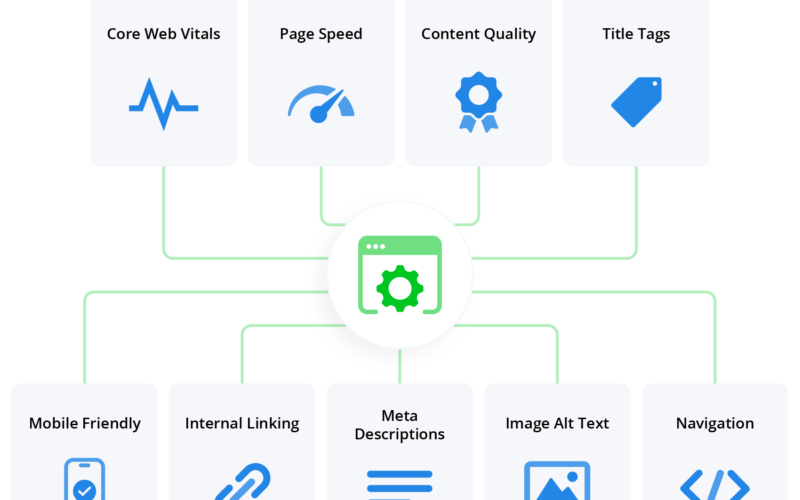A to Z On Page SEO: A Comprehensive Guide to Boost Your Website Rankings
Search Engine Optimization (SEO) is an ever-evolving field that requires a multi-faceted approach to improve your website’s visibility on search engines. Here’s an A-to-Z guide to cover all essential SEO tasks you should focus on to achieve better rankings, drive organic traffic, and enhance user experience.
A – Audit Your Website
Start with an in-depth website audit to identify issues such as broken links, duplicate content, slow-loading pages, and poor keyword targeting. Use tools like Google Search Console, SEMrush, or Ahrefs to analyze your site’s performance.
B – Build Backlinks
High-quality backlinks from authoritative sites significantly boost your domain authority and rankings. Focus on natural link-building through outreach, guest posting, and creating share-worthy content.
C – Create Quality Content
Content is king in SEO. Develop informative, engaging, and keyword-rich content that solves user problems. Include blogs, videos, infographics, and case studies.
D – Design for User Experience (UX)
A user-friendly website design enhances engagement and reduces bounce rates. Optimize your site’s layout, navigation, and visuals for better usability.
E – Enhance Page Speed
Fast-loading websites rank higher and provide a better user experience. Use tools like Google PageSpeed Insights to identify issues and optimize your site’s speed.
F – Fix Broken Links
Broken links negatively impact both user experience and search engine rankings. Regularly check for and fix broken internal and external links.
G – Google My Business (GMB)
Optimize your GMB profile to improve local SEO. Add accurate business details, images, reviews, and updates to attract local customers.
H – Header Tags Optimization
Use header tags (H1, H2, H3) effectively to structure your content. Include keywords in headers to make your content more SEO-friendly and scannable.
I – Improve Mobile Responsiveness
Ensure your site is mobile-friendly since most users access websites via mobile devices. Use responsive design and test your site on Google’s Mobile-Friendly Test tool.
J – Join Social Media Platforms
Leverage social media to promote your content and drive traffic to your site. Social signals, while not a direct ranking factor, enhance brand awareness and engagement.
K – Keyword Research
Identify high-performing keywords relevant to your audience. Use tools like Google Keyword Planner, SEMrush, or Ahrefs to find low-competition, high-traffic keywords.
L – Leverage Schema Markup
Implement structured data (schema markup) to help search engines understand your site’s content. This improves your chances of appearing in rich snippets.
M – Meta Tags Optimization
Craft compelling title tags and meta descriptions that include your primary keywords. These elements impact click-through rates and search visibility.
N – Nurture Local SEO
Optimize your site for local search by using location-based keywords, creating localized content, and ensuring consistency in NAP (Name, Address, Phone) across directories.
O – Optimize Images
Compress image sizes, use descriptive file names, and include alt text with keywords to improve load times and image search rankings.
P – Publish Regular Content
Consistency is key. Regularly publish fresh, high-quality content to keep users engaged and encourage search engines to crawl your site frequently.
Q – Quality Over Quantity
Focus on creating fewer, high-quality pages rather than a large number of low-value pages. Quality content drives more traffic and conversions.
R – Revamp Old Content
Update and repurpose old content to maintain relevance and improve rankings. Refresh outdated statistics, add new insights, and optimize with current keywords.
S – Secure Your Website (HTTPS)
Switch to HTTPS to ensure your site is secure. Search engines prioritize secure websites, and users trust them more.
T – Track Your Performance
Monitor your site’s performance using analytics tools like Google Analytics and Google Search Console. Keep track of traffic, keyword rankings, and user behavior.
U – Use Internal Linking
Strategically link to other pages on your website to improve navigation, distribute link equity, and help search engines understand your site’s structure.
V – Voice Search Optimization
Optimize your content for voice search by targeting conversational keywords and answering common questions in your niche.
W – Write for Humans, Not Just Search Engines
Prioritize user experience by writing natural, engaging content that answers queries and adds value. Avoid keyword stuffing and overly technical language.
X – XML Sitemap Submission
Create and submit an XML sitemap to search engines to help them crawl and index your website more efficiently.
Y – Your Content’s E-A-T (Expertise, Authority, Trustworthiness)
Demonstrate your expertise, authority, and trustworthiness through well-researched content, citations, and an active online presence.
Z – Zero-In on User Intent
Understand what users are searching for and create content that matches their intent. Cater to informational, navigational, and transactional queries to cover all bases.
By implementing this A-to-Z guide, you’ll cover all essential aspects of SEO, setting your website up for long-term success in search engine rankings.
Optimize Your Website for Success Today!
At Search Engine Ways, we go beyond simple optimization—we create strategies that transform your website into a powerful tool for growth. With our A to Z On-Page SEO Services, you can unlock your site’s true potential, improve search rankings, and achieve your business goals.
Ready to dominate the search results? Contact us now to get started on your on-page SEO journey!

